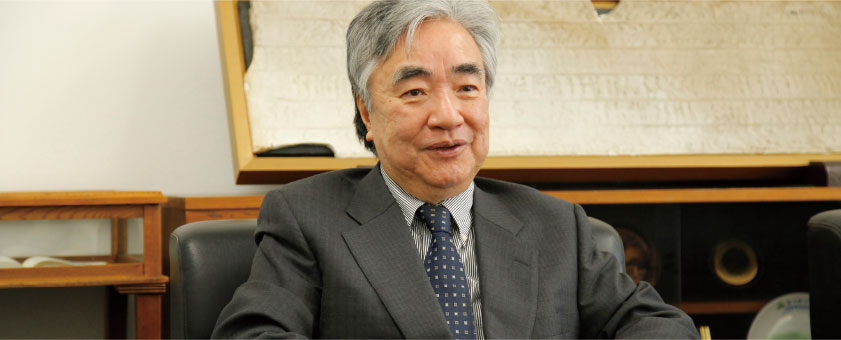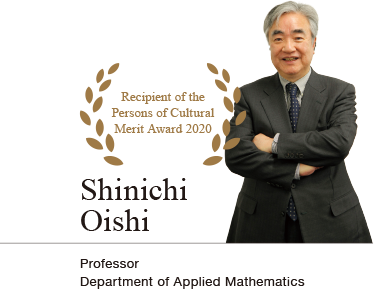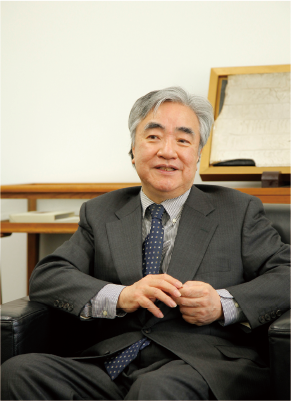



Professor Shinichi Oishi from the Department of Applied Mathematics, School of Fundamental Science and Engineering, was selected as the recipient of the Persons of Cultural Merit Award 2020. We interviewed Professor Oishi, who has established an innovative numerical computation method with the result verification, about his life as a researcher, his vision, and what he expects from Waseda University students.
The antithesis of two geniuses who established the basis for computers saying “It is difficult to detect errors in numerical computations.”
Q.Tell us about your research.
I have been studying verified numerical computation, an approach to detect exact errors in numerical computations done by computers, for 30 years. The two geniuses who established the basis for computers, John von Neumann and Alan Turing, who is famous for cracking the Enigma code, published a paper on the difficulty of accurately detecting exact errors in numerical computations in the 1950s. Thus, the idea that it is difficult to detect errors in numerical computations has become the norm. In fact, even super computers often ignore to detect errors in numerical computations rigorously. Verified computation is the antithesis of such a culture. It has been very hard to tackle the problem that the two geniuses found difficult. Verified computation is the field that studies this theme. However, 70 years have passed since verified computation emerged, and it has finally started to have a significant impact across various fields of science, including mathematics and computational science.
The emergence of a genius changed soliton research from a field of dreams into a barren field. “Decided to switch to a different field.”
Q.Tell us your story before you started your research on verified numerical computation.
I went to Waseda University Senior High School. Because I didn’t have to study for the entrance examination, I pursued what I loved to study. I was fascinated by literature, mathematics, and science. Then I entered the Department of Electronics and Communications (later reorganized to form the Department of Computer Science and Engineering and Department of Communications and Computer Engineering), School of Science and Engineering. When I was a university student, I studied what I wanted regardless the curriculum of our class. Because I was fascinated into quantum mechanics, I wanted to write a graduation thesis on communications using quantum effects. However, such a research field was not yet started in 1975. Thus, I thought I could write a thesis on solitons that could be solved using the inverse scattering problem in quantum mechanics that I learned from a new book being published in 1974, the second volume of the classical physics, which is included in a series of books published by Iwanami Shoten entitled “Fundamentals of Modern Physics, Lecture Series (total 12 volumes)’’. A soliton is a model of nonlinear waves and was one of the subjects in the field of advanced mathematics and physics called nonlinear science. I sought guidance from Professor Kazuo Horiuchi, who was conducting mathematical research in the Department of Electronics and Communications back then. Then, Professor Takeyasu Kotera from Tokyo University of Education (later, professor at the University of Tsukuba,) who often visited Horiuchi Lab to participate in seminars, invited me to participate in the Toda Seminar. So, I joined the most advanced soliton research seminar at the time.
I discovered in the first year of the master’s program that certain class of bilinear equations always have two-soliton solutions. After that, I extended what I had discovered and found generalized soliton solutions in the form of Fredholm determinants. And I also discovered that the initial value problem could be solved if bilinear equations had those generalized soliton solutions. I was able to apply this finding widely and compile papers almost every month in the second year of the doctoral program. Many of them were published in the Journal of the Physical Society of Japan by the Physical Society of Japan, and I received not a small number of letters requesting reprints from all over the world, which give me a lot of pleasure.
Then. Professor Mikio Sato, a mathematician whom I respected because he invented truly innovative mathematical theories, started working on soliton research and showed that soliton equations could be classified using the infinite-dimensional Lie algebra theory. The idea for many papers I planned to write after completing my doctorate was just proved by him.
Thus, I decided to conduct research in a different field. I thought I had to choose a field that Professor Sato would not want to work in. Then, I learned that there was a field where research was conducted to solve nonlinear equations by finding fixed points using computers. I was considering finding exact solutions using this method, and then a survey on verified numerical computation was published in 1990, and I thought “This is the desired research area”. It was a field of computer-assisted proofs focusing on finding exact solutions to nonlinear equations by detecting errors rigorously in numerical computations. The fact that those equations might not be solved using algebraic theories was also appealing. I found the theory interesting and learned that I would need to make steady efforts to rewrite every numerical computation theory in order to detect errors rigorously in numerical computations. Because this field uses inequalities to find the range of solutions instead of finding the solution algebraically using equalities and calculate errors in numerical computations efficiently wisely optimizing the computation procedures using the architecture of modern computers, I intuitively feel it was not a field where research would progress in one overnight, and I was right. I think I was able to implement a grandiose plan to rewrite every numerical computation theory from the aspect of calculating errors in numerical computations rigorously.
“I almost cannot sleep because I continuously find a new interesting nonlinear equations rigorously solvable by a computer assisted analysis utilizing verified numerical computation.” Continue pursuing dreams.
Q.What is your future vision?
Now I’m trying to prove that there exist complex solutions to nonlinear delay differential equations, nonlinear differential equations with delays, using verified computation. For example, On the Origin of Species by Charles Darwin only has a single illustration that shows the transformation of the diversification of species, and it is said that there are nonlinear delay differential equations with this illustration as the solution. It is extremely difficult to prove that such complex solutions exist, so I’d like to prove it with computer-assisted analysis using verified computation. Verified computation allows us to exactly solve more equations that we couldn’t solve without computers and makes my everyday life exciting. I plan to work on many research themes.
Q.Is there anything you would like to say to Waseda students?
I want our students to care about themselves no matter what and enjoy their university lives while considering what research they may find fun. Please stick to your beliefs of pursuing what you are interested in and enjoy to surely contribute to humanity, and carve your own path. It is natural for you to feel insecure. However, I think you will feel extremely happy when your dreams come true because you felt insecure along the way.